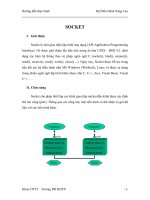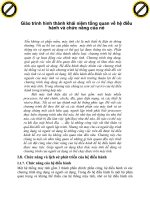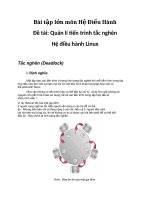Process (hệ điều HÀNH NÂNG CAO SLIDE)
Bạn đang xem bản rút gọn của tài liệu. Xem và tải ngay bản đầy đủ của tài liệu tại đây (346.73 KB, 44 trang )
Chapter 3. Process
OBJECTIVES
• To introduce the notion of a process - a program
in execution, which forms the basis of all
computation.
• To describe the various features of processes,
including scheduling, creation and termination,
and communication.
• To describe communication in client-server
systems.
1. Process Concept
• An operating system executes a variety of
programs:
– Batch system –jobs
– Time-shared systems –user programs or tasks
– A user may be able to run several programs at
one time: a word processor, a web browser,
and an e-mail package...
• Process is a program in execution; process
execution must progress in sequential fashion
1.1. The Process
A process includes
• The current activity, as represented by the value
of the program counter and the contents of the
processor's registers.
• The stack, which contains temporary data (such
as function parameters, return addresses, and
local variables)
• A data section, which contains global variables.
• A process may also include a heap, which is
memory that is dynamically allocated during
process run time.
Figure 1. Process in memory.
1.2 Process State
• As a process executes, it changes state. Each
process may be in one of the following states:
– New. The process is being created.
– Running. Instructions are being executed.
– Waiting. The process is waiting for some
event to occur (such as an I/O completion or
reception of a signal).
– Ready. The process is waiting to be assigned
to a processor.
– Terminated. The process has finished
execution.
Figure 2. Diagram of process state.
• It is important to realize that only one process
can be running on any processor at any instant.
Many processes may be ready.
1.3 Process Control Block (PCB)
• Each process is represented in the operating
system by a process control block (PCB)—
also called a task control block.
Figure 3. Process control block (PCB).
• Process state. The state may be new, ready,
running, waiting and halted.
• Program counter. The counter indicates the
address of the next instruction to be executed for
this process.
• CPU registers. The registers vary in number
and type, depending on the computer
architecture. They include accumulators, index
registers, stack pointers, and general-purpose
registers, plus any condition-code information.
• CPU-scheduling information. This information
includes a process priority, pointers to scheduling
queues, and any other scheduling parameters.
• Memory-management
information.
This
information may include such information as the
value of the base and limit registers, the page
tables, or the segment tables, depending on the
memory system used by the operating system.
• Accounting information. This information
includes the amount of CPU and real time used,
time limits, account numbers, job or process
numbers, and so on.
• I/O status information. This information
includes the list of I/O devices allocated to the
process, a list of open files, and so on.
Figure 4. Diagram showing CPU switch from
process to process.
2. Process Scheduling
• The objective of multiprogramming is to have
some process running at all times, to maximize
CPU utilization.
• The objective of time sharing is to switch the
CPU among processes so frequently that users
can interact with each program while it is
running.
• To meet these objectives, the process
scheduler selects an available process (possibly
from a set of several available processes) for
program execution on the CPU.
2.1. Scheduling Queues
• As processes enter the system, they are put into
a job queue, which consists of all processes in
the system.
• The processes that are residing in main memory
and are ready and waiting to execute are kept on
a list called the ready queue.
• The list of processes waiting for a particular I/O
device is called a device queue. Each device
has its own device queue.
• Processes migrate among the various queues
Figure 5. The ready queue and various I/O device queues.
• A common representation for a discussion of
process scheduling is a queueing diagram.
Figure 6. Queueing-diagram representation of
process scheduling.
• A new process is initially put in the ready queue.
It waits there until it is selected for execution, or
is dispatched. Once the process is allocated the
CPU and is executing, one of several events
could occur:
– The process could issue an I/O request and
then be placed in an I/O queue.
– The process could create a new subprocess
and wait for the subprocess's termination.
– The process could be removed forcibly from
the CPU, as a result of an interrupt, and be put
back in the ready queue.
2.2. Schedulers
• The selection process is carried out by the
appropriate scheduler.
• Often, in a batch system, more processes are
submitted than can be executed immediately.
These processes are spooled to a mass-storage
device (typically a disk), where they are kept for
later execution.
• The long-term scheduler, or job scheduler,
selects processes from this pool and loads them
into memory for execution.
• The short-term scheduler, or CPU scheduler,
selects from among the processes that are ready
to execute and allocates the CPU to one of them.
• The primary distinction between these two
schedulers lies in frequency of execution.
– The short-term scheduler must select a new
process for the CPU frequently. A process may
execute for only a few milliseconds before
waiting for an I/O request (fast).
– The long-term scheduler executes much less
frequently; minutes may separate the creation
of one new process and the next (low).
• The long-term scheduler controls the degree of
multiprogramming (the number of processes in
memory).
• In general, most processes can be described as
either I/O bound or CPU bound.
– An I/O-bound process is one that spends
more of its time doing I/O than it spends doing
computations.
– A CPU-bound process, in contrast, generates
I/O requests infrequently, using more of its
time doing computations.
• It is important that the long-term scheduler select
a good process mix of I/O-bound and CPUbound processes.
• On some systems, the long-term scheduler may
be absent or minimal.
– For example, time-sharing systems such as
UNIX and Microsoft Windows systems often
have no long-term scheduler but simply put
every new process in memory for the shortterm scheduler.
– The stability of these systems depends either
on a physical limitation (such as the number of
available terminals) or on the self-adjusting
nature of human users.
– If the performance declines to unacceptable
levels on a multiuser system, some users will
simply quit.
• Some operating systems, such as time-sharing
systems,
may
introduce
an
additional,
intermediate level of scheduling. This mediumterm scheduler
– The key idea behind a medium-term scheduler
is that sometimes it can be advantageous to
remove processes from memory (and from
active contention for the CPU) and thus reduce
the degree of multiprogramming.
– Later, the process can be reintroduced into
memory, and its execution can be continued
where it left off. This scheme is called
swapping. The process is swapped out, and is
later swapped in.
Figure 7. Addition of medium-term scheduling
to the queueing diagram.
3. Operations on Processes
3.1. Process Creation
• Parent process create children processes,
which, in turn create other processes, forming a
tree of processes.
• Most operating systems (including UNIX and the
Windows family of operating systems) identify
processes according to a unique process
identifier (or pid), which is typically an integer
number.
• In general, a process will need certain resources
(CPU time, memory, files, I/O devices) to
accomplish its task. It maybe
– Parent and children share all resources
– Children share subset of parent’s resources
– Parent and child share no resources
• When a process creates a new process, two
possibilities exist in terms of execution:
– The parent continues to execute concurrently
with its children.
– The parent waits until some or all of its
children have terminated.
• There are also two possibilities in terms of the
address space of the new process:
– The child process is a duplicate of the parent
process (it has the same program and data as
the parent).
– The child process has a new program loaded
into it.
3.2. Process Termination
• A process terminates when it finishes executing
its final statement and asks the operating system
to delete it by using the exit () system call.
– The process may return a status value to its
parent process.
– All the resources of the process—including
physical and virtual memory, open files, and
I/O buffers-are deallocated by the operating
system.









